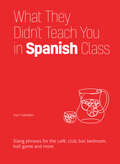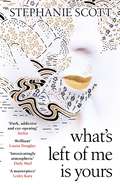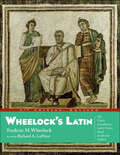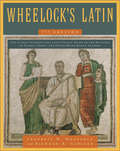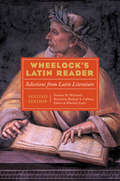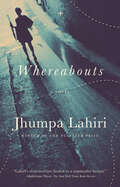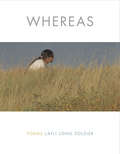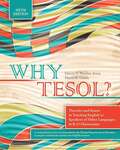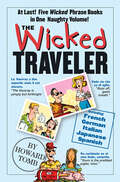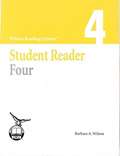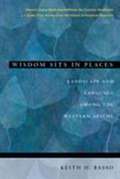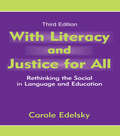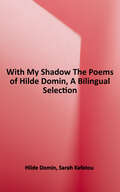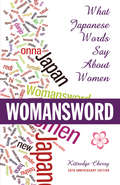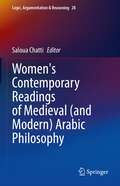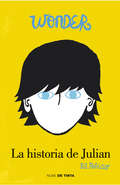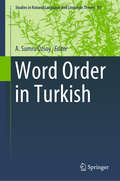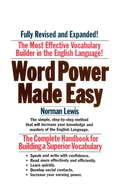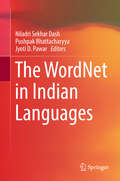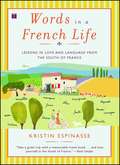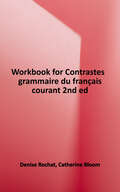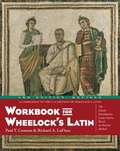- Table View
- List View
What They Didn't Teach You in Spanish Class: Slang Phrases for the Cafe, Club, Bar, Bedroom, Ball Game and More (Dirty Everyday Slang)
by Juan CaballeroChilling with an ice-cold cerveza at a beach bar...Dancing at CDMX&’s hottest salsa club...Screaming your head off at the Copa América...Drop the textbook formality and chat with the locals in Latin America&’s everyday language.• What&’s up? ¿Qué tal?• What a hottie! ¡Que cuerazo!• Let&’s pound these shots. Tráguemonos estos traguitos.• That ref sucks. Es una mierda ese árbitro/a.• I&’m craving all-you-can-eat tacos. Me antoja un poco de taquiza libre.• Do you wanna hook up? ¿Quieres ligar?
What We Talk About When We Talk About Love (Mandarin Edition)
by Raymond CarverIn his second collection of stories, as in his first, Carver's characters are peripheral people--people without education, insight or prospects, people too unimaginative to even give up. Carver celebrates these men and women. 当我们谈论爱情时我们在谈论什么 是雷蒙德·卡佛优秀的短篇小说集 由17篇短篇小说组成 讲述了如餐馆女招待,锯木厂工人,修车工,推销员和汽车旅馆管理员等社会底层的体力劳动者的生活 这些普通人有着普通人的愿望 做着再普通不过的事情 但他们发现自己在为生存而挣扎 无法达到在常人看来并不远大的人生目标 他们的生活中充满了窘困和不如意 婚姻破裂 失业 酗酒 破产 卡佛用"极简"的遣词,冷静疏离的叙事 表现了现代社会中人的边缘性以及现代人脆弱的自我意识 本书的出版 为美国短篇小说写作注入了新的生命 并为卡佛赢得了"美国的契诃夫"的称号 使他成为美国继海明威之后受到模仿最多的作家
What's Left of Me is Yours
by Stephanie ScottA BOOK OF THE YEAR FOR THE DAILY MAIL AND WOMAN AND HOMEA New York Times 'Editor's Pick'One of the Observer's Ten Best Debut Novelists of 2020Shortlisted for the Author's Club First Novel AwardLonglisted for the Jhalak PrizeLonglisted for the CWA John Creasy New Blood Dagger'Enrapturing... This richly imagined novel considers the many permutations of love and what we are capable of doing in its name' New York Times'A brilliant debut' Louise Doughty, author of Apple Tree Yard'You'll have the heart rate of an Olympic hurdler' Sunday Express'I read it with my heart in my throat' Sara Collins, author of The Confessions of Frannie Langton 'An exquisitely crafted masterpiece you'll be pressing into the hands of others' Woman & Home 'An intoxicatingly atmospheric mystery' Daily Mail'Dark, addictive and eye-opening, this is a brilliant debut' StylistA gripping debut set in modern-day Tokyo and inspired by a true crime, What's Left of Me Is Yours follows a young woman's search for the truth about her mother's life - and her murder.In Japan, a covert industry has grown up around the wakaresaseya (literally "breaker-upper"), a person hired by one spouse to seduce the other in order to gain the advantage in divorce proceedings.When Sato hires Kaitaro, a wakaresaseya agent, to have an affair with his wife, Rina, he assumes it will be an easy case. But Sato has never truly understood Rina or her desires and Kaitaro's job is to do exactly that - until he does it too well.While Rina remains ignorant of the circumstances that brought them together, she and Kaitaro fall in a desperate, singular love, setting in motion a series of violent acts that will forever haunt her daughter Sumiko's life.Told from alternating points of view and across the breathtaking landscapes of Japan, What's Left of Me Is Yours explores the thorny psychological and moral grounds of the actions we take in the name of love, asking where we draw the line between passion and possession.
Wheelock's Latin: The Classic Introductory Latin Course, Based on Ancient Authors
by Frederic M. WheelockThe classic, single–volume introductory Latin textbook, introduced in 1956 and still the bestselling and most highly regarded textbook of its kind. Wheelock's Latin, sixth edition, revised, has all the features that have made it the best–selling single–volume beginning Latin textbook, many of them revised and expanded: o 40 chapters with grammatical explanations and readings based on ancient Roman authors o Self–tutorial exercises with an answer key for independent study o An extensive English–Latin/ Latin–English vocabulary section o A rich selection of original Latin readings –– unlike other textbooks which contain primarily made–up Latin texts o Etymological aids Also includes maps of the Mediterranean, Italy and the Aegean area, as well as numerous photographs illustrating aspects of classical culture, mythology, and historical and literary figures presented in the chapter readings. o The leading self–tutorial Latin program. Also great for college and accelerated high school courses. o Wheelock's Latin is the top–selling Latin reference in the US. o Interest and enrolments in Latin have been steadily rising in the U.S. for the past 20 years. One–half million people are currently enrolled in Latin classes, and at least 10,000 teachers, professors and graduate assistants are teaching the language in America.
Wheelock's Latin 7th Edition
by Richard A. LafleurFor nearly sixty years, Wheelock's Latin has remained the opitmus liber of beginning Latin textbooks. When Professor Frederic M. Wheelock's Latin first appeared in 1956, the reviews extolled its thoroughness, organization, and conciseness; one reviewer predicted that the book "might well become the standard text" for introducing students to elementary Latin. Now, nearly six decades later, that prediction has certainly proved accurate.This new edition of Wheelock's Latin has all of the features, many of them improved and expanded, that have made it the bestselling single-volume beginning Latin textbook: 40 chapters with grammatical explanations and readings drawn from the works of Rome's major prose and verse writers; Self-tutorial exercises, each with an answer key, for independent study; An extensive English-Latin/Latin-English vocabulary section; A rich selection of original Latin readings--unlike other Latin textbooks, which contain primarily made-up texts; Etymological aids, maps, and dozens of images illustrating aspects of the classical culture and mythology presented in the chapter readings. Also included are expanded notes on the literary passages, comments on vocabulary, and translation tips; new comprehension and discussion questions; and new authentic classical Latin readings, including Roman graffiti, in every chapter. <P><P><i>Advisory: Bookshare has learned that this book offers only partial accessibility. We have kept it in the collection because it is useful for some of our members. To explore further access options with us, please contact us through the Book Quality link. Benetech is actively working on projects to improve accessibility issues such as these.</i>
Wheelock's Latin Reader, 2e
by Richard A. LafleurOriginally intended by Professor Frederic M. Wheelock as a sequel to Wheelock's Latin, his classic introductory Latin textbook, Wheelock's Latin Reader, newly revised and updated by Richard A. LaFleur, is the ideal text for any intermediate-level Latin course. You'll find a rich selection of of prose and poetry from a wide range of classical authors, as well as briefer passages from medieval and Late Latin writers, each presented in the Latin in which it was originally written. Useful features include extensive notes; a complete Latin-English vocabulary; maps of ancient Italy, Greece, and the Roman Empire; and numerous photographs illustrating aspects of classical culture, mythology, and history featured in the readings.
Whereabouts: A Novel (Vintage Contemporaries Ser.)
by Jhumpa LahiriA marvelous new novel from the Pulitzer Prize-winning author of The Lowland and Interpreter of Maladies--her first in nearly a decade. <P><P>Exuberance and dread, attachment and estrangement: in this novel, Jhumpa Lahiri stretches her themes to the limit. The woman at the centre wavers between stasis and movement, between the need to belong and the refusal to form lasting ties. The city she calls home, an engaging backdrop to her days, acts as a confidant: the sidewalks around her house, parks, bridges, piazzas, streets, stores, coffee bars. We follow her to the pool she frequents and to the train station that sometimes leads her to her mother, mired in a desperate solitude after her father's untimely death. In addition to colleagues at work, where she never quite feels at ease, she has girl friends, guy friends, and "him," a shadow who both consoles and unsettles her. But in the arc of a year, as one season gives way to the next, transformation awaits. One day at the sea, both overwhelmed and replenished by the sun's vital heat, her perspective will change. <P><P>This is Jhumpa Lahiri's first novel written in Italian. It brims with the impulse to cross barriers. By grafting herself onto a new literary language, Lahiri has pushed herself to a new level of artistic achievement. <P><P><b>A New York Times Best Seller</b>
WHEREAS: Poems
by Layli Long SoldierThe astonishing, powerful debut by the winner of a 2016 Whiting Writers' AwardWHEREAS her birth signaled the responsibility as mother to teach what it is to be Lakota therein the question: What did I know about being Lakota? Signaled panic, blood rush my embarrassment. What did I know of our language but pieces? Would I teach her to be pieces? Until a friend comforted, Don’t worry, you and your daughter will learn together. Today she stood sunlight on her shoulders lean and straight to share a song in Diné, her father’s language. To sing she motions simultaneously with her hands; I watch her be in multiple musics.—from “WHEREAS Statements”WHEREAS confronts the coercive language of the United States government in its responses, treaties, and apologies to Native American peoples and tribes, and reflects that language in its officiousness and duplicity back on its perpetrators. Through a virtuosic array of short lyrics, prose poems, longer narrative sequences, resolutions, and disclaimers, Layli Long Soldier has created a brilliantly innovative text to examine histories, landscapes, her own writing, and her predicament inside national affiliations. “I am,” she writes, “a citizen of the United States and an enrolled member of the Oglala Sioux Tribe, meaning I am a citizen of the Oglala Lakota Nation—and in this dual citizenship I must work, I must eat, I must art, I must mother, I must friend, I must listen, I must observe, constantly I must live.” This strident, plaintive book introduces a major new voice in contemporary literature.
Why Tesol? Theories And Issues In Teaching English To Speakers Of Other Languages In K-12 Classrooms
by Eileen Ariza Maria Coady BedardWhy TESOL? Fifth Edition, provides classroom and preservice teachers with a knowledge base to effectively teach in culturally and linguistically diverse classrooms in today’s global environment. It provides in depth theoretical background, legal information, and application for teachers to address the needs of English learners. Why TESOL? is written so teachers from various backgrounds and experiences can readily apply ESOL concepts to their individual mainstream classroom settings. FEATURED TOPICS Describes the legal rights of English language learners (ELs); provides an historical overview of laws (e.g., ESSA) in the United States that affect the education of EL students, and provides a clear classification of English as a second/new language (ESL/ENL) programs available in the United States. Helps readers understand the complexities of acquiring an additional language by providing a basic grounding in the core areas of linguistics and other related areas, such as non-verbal communication, dialectal variation, English language use, development, translanguaging, and literacy. Discusses first and second/new language theories and models, including processes and non-linguistic factors that affect second or additional language acquisition. Includes national statistics that illuminate the global nature of American society in the twenty-first century. Includes classroom experiences of new and experienced teachers, and provides examples adapting teaching strategies to better measure the academic success of second language learners in mainstream classrooms. Includes new chapters on literacy development, and family engagement for EL students. INCLUDES learning objectives for each chapter, discussion and reflection questions, and activities. Each chapter also provides web resources and links for extended learning.
The Wicked Traveler: 8-copy Counter Display (Wicked Travel Ser.)
by Howard Tomb<P>Respond to Japanese Noh theater like a native: Kazoku sorrote no seppuku ga yokatta. (“I love the part where the whole family disembowels themselves.”) <P>Speak to homicidal Parisian taxi drivers in a language they’ll understand: Ou avez-vous appris à conduire? <P>En Italie? (“Where did you learn to drive? Italy?”) <P>Discuss Italian olive oil with the proper degree of reverence: Un assaggio ti dice che le olive sono maturate di fronte ad una cattedrale. (“One taste tells you the olives grew in full view of the cathedral.”) <P>Establish privacy needs in Mexico: Preferiría una habitación sin alacranes. (“I’d prefer a room without scorpions.”) <P>With seven titles and over 1.2 million copies in print, Howard Tomb’s Wicked phrase book series is the fiendishly irreverent—and very successful—collection that gives travelers the words they wish they could utter while, say, attempting to find the exit of the Louvre or facing a plate of fugu (poisonous blowfish) in Japan. Now, the five most popular Wicked books—Italian, French, Japanese, German, and Spanish— have been updated and compiled into The Wicked Traveler. <P>Because, as Howard Tomb writes in his new introduction: “Every country is different, but all foreign places have one thing in common: they’re weird.”
Will You Please Be Quiet, Please? (Mandarin Edition)
by Raymond CarverWith this, his first collection of stories, Raymond Carver breathed new life into the American short story. Carver shows us the humor and tragedy that dwell in the hearts of ordinary people; his stories are the classics of our time. 请你安静些,好吗? 是卡佛文学创作的处女作 是卡氏风格的奠基之作 为其一生的创作主旨设定了基调 同时也是其第一本具有广泛影响力的短篇小说集 它于1976年在美国甫一出版即获好评 并于1977年被题名国家图书奖 卡佛曾说过 "对大多数人而言 人生不是什么冒险 而是一股莫之能御的洪流 "在这本短篇小说集里 我们所看到的 就是这样的人生片段 它写的完全不是冒险奋战的英雄人物 而是我们身边毫不起眼却终日陷在生活琐事,人际关系难题里的小人物 卡佛以极简的文字 将生活中最不起眼的时刻写得朴实而暗含张力 他的风格影响了当今许多名家
Williams Hebrew Syntax (3rd Edition)
by John C. BeckmanAlthough the morphology and lexicon of Hebrew are reasonably well understood, its syntax has long been a neglected area of study. Syntax, the relationship of words to one another, forms, together with morphology, the material of grammar. Its relative importance varies according to the language considered. This is particularly true of word order, for when an inflected language loses its case endings, word order assumes many of the functions of the former cases. <P><P> This outline by Professor Williams re-emphasizes the significance of word order in Hebrew. Developed over fifteen years in a formal course on Hebrew syntax at the University of Toronto, it treats the syntax of the noun, the verb, particles and clauses, with a selection of illustrative examples. Its contents are based on classical Hebrew prose, but some account is also taken of the deviations in later prose and poetry. In this new edition English translations have been provided for all Hebrew phrases and sentences, and the bibliography has been expanded.<P> Advisory: Bookshare has learned that this book offers only partial accessibility. We have kept it in the collection because it is useful for some of our members. To explore further access options with us, please contact us through the Book Quality link on the right sidebar. Benetech is actively working on projects to improve accessibility issues such as these.
Wilson Reading System: Student Reader Four (Wilson Reading System)
by Barbara A. WilsonStudents gain accuracy and automaticity by practicing skills with a substantial amount of controlled text. Word lists, sentences, and stories are 98% decodable throughout the entire 12 Steps.
Wisdom Sits In Places: Landscapes and Language Among the Western Apache
by Keith H. BassoFour essays recount stories Western Apaches tell about the landscape. Includes comments from a cultural anthropologist.
With Literacy and Justice for All: Rethinking the Social in Language and Education (Language, Culture, and Teaching Series)
by Carole EdelskyThe third edition of With Literacy and Justice for All: Rethinking the Social in Language and Education continues to document Carole Edelsky's long involvement with socially critical, holistic approaches to the everyday problems and possibilities facing teachers of language and literacy. This book helps education professionals understand the educational/societal situations they are dealing with, and literacy instruction and second language learning in particular contexts. Edelsky does not offer simplistic pedagogical formulas, but rather, progressively works through differences and tensions in the discourses and practices of sociolinguistics, bilingual education, whole language, and critical pedagogy--fields whose practitioners and advocates too often work in isolation from each other and, at times, at cross purposes. In this edition, what Edelsky means by rethinking is improving and extending her own views, while at the same time demonstrating that such rethinking always occurs in the light of history. The volume includes a completely new Introduction and two entirely new chapters: one on reconceptualizing literacy learning as second language learning, and another on taking a historical view of responses to standardized testing. Throughout, in updating the volume, Edelsky uses a variety of structural styles to note contrasts in her views across time and to make the distinction clear between the original material and the current additions. This edition is a rare example of a scholarly owning-up to changes in thinking, and a much needed demonstration of the historically grounded nature of knowledge. As a whole, the third edition emphasizes recursiveness and questioning within a deliberately political framework.
With My Shadow: The Poems of Hilde Domin, A Bilingual Selection
by Hilde Domin“These translations and poems are full of the refugee’s loss and longing, made infinitely richer by Kafatou’s love for the poet and poems. This is a deeply loving, compassionate collection of poems, remaining anchored, ultimately, in the exile’s intertwined desire and nostalgia for home.” —The Massachusetts Review Not to tire / but to hold out your hand / gently / as to a bird / to the miracle This bilingual edition of the poems of Hilde Domin, an outstanding lyric poet of exile and return, brings her work to English-speaking readers for the first time. Hilde Domin fled Nazi Germany when, as a Jew, she was no longer safe there. For many years she lived in Italy and the Dominican Republic, where she encountered modernist currents in Italian and Spanish poetry. Returning permanently to Germany in the mid-1950s, she quickly found recognition as a poet of memory and reconciliation. For the rest of her long life she wrote and spoke in a tone poised between vulnerability and trust, on behalf of moral and civic values worth living for. <p><p>As Sarah Kafatou writes in her Introduction, Domin “is always frugal: she reworks and transforms her repertoire of metaphors, images, themes, and ideas again and again, extending and refining, never explaining too much. Her lyric sensibility is concise, her syntax and vocabulary are simple and apt, her short lines break on the phrase, and she has an uncanny ability to hit the right note at exactly the right moment, according to the rhythm of the breath.” Domin writes of “people like us we among them,” providing a voice for victims of persecution everywhere. Today, with refugee populations on the move throughout the world and with rising intolerance and polarization, these poems of conscience, and courage discovered in desperation, will speak directly to every reader.
Womansword: What Japanese Words Say About Women
by Kittredge Cherry"A very graceful, erudite job . . . extraordinarily revealing."-The New York Times Thirty years after its first publication, Womansword remains a timely, provocative work on how words reflect female stereotypes in modern Japan. Short, lively essays offer linguistic, sociological, and historical insight into issues central to the lives of women everywhere: identity, girlhood, marriage, motherhood, work, sexuality, and aging. A new introduction shows how things have-and haven't-changed.Kittredge Cherry studied in Japan and has written about the country for Newsweek and the Wall Street Journal. She has a journalism degree from University of Iowa.
Women's Contemporary Readings of Medieval (Logic, Argumentation & Reasoning #28)
by Saloua ChattiThis book explores a large variety of topics involved in Arabic philosophy. It examines concepts and issues relating to logic and mathematics, as well as metaphysics, ethics and aesthetics. These topics are all studied by different Arabic philosophers and scientists from different periods ranging from the 9th century to the 20th century, and are representative of the Arabic tradition. This is the first book dealing with the Arabic thought and philosophy and written only by women. The book brings together the work and contributions of an international group of female scholars and researchers specialized in the history of Arabic logic, philosophy and mathematics. Although all authors are women, the book does not enter into any kind of feminist trend. It simply highlights the contributions of female scholars in order to make them available to the large community of researchers interested in Arabic philosophy and to bring to the fore the presence and representativeness of female scholars in the field.
Wonder. La historia de Julian
by R. J. PalacioWonder. La lección de August ha recordado a miles de lectores la importancia de ser amable. Pero este no es un libro sobre August, un niño que quiere ser normal a pesar de su aspecto, sino sobre Julian. ¿Qué motivos tiene Julian para odiar a August?¿Será capaz de asumir sus errores y empezar de nuevo? Wonder. La historia de Julian trata sobre el niño que peor se porta con Auggie. No soporta verlo, no soporta que sea amigo de Jack, no soporta que esté en su colegio... y no es capaz de darse cuenta del impacto que sus actos pueden tener en los demás. Provocadora, sorprendente y emotiva, Wonder. La historia de Julian deleitará a los lectores de Wonder. La lección de August... y a los que todavía no la han leído.
Word Order in Turkish (Studies in Natural Language and Linguistic Theory #97)
by A. Sumru ÖzsoyThis volume is a collection of studies on various aspects of word order variation in Turkish. As a head-final, left-branching ‘free’ word order language, Turkish raises a number of significant theory-internal as well as language-particular questions regarding linearization in language. Each of the contributions in the present volume offers a fresh insight into a number of these questions, thus, while expanding our knowledge of the language-particular properties of the word order phenomena, also contribute individually to the theory of linearization in general. Turkish is a configurational language. It licenses constructions in which constituents can occur in non-canonical presubject as well as postverbal positions. Presented within the assumptions of the generative tradition, the discussion and analyses of the various aspects of the linearization facts of the language offer a novel treatment of the issues therein. The authors approach the word order phenomena from a variety of perspectives, ranging from purely syntactic treatments, to accounts as syntax-PF interface or syntax-discourse interface phenomena or as output of base generation.
Word Power Made Easy: The Complete Handbook for Building a Superior Vocabulary
by Norman LewisThe most effective vocabulary builder in the English language provides a simple, step-by-step method that will increase your knowledge and mastery of written and spoken English. Word Power Made Easy does more than just add words to your vocabulary. It teaches ideas and a method of broadening your knowledge as an integral part of the vocabulary building process. Do you always use the right word? Can you pronounce it—and spell it—correctly? Do you know how to avoid illiterate expressions? Do you speak grammatically, without embarrassing mistakes? If the answer to any of these questions is no, you need Word Power Made Easy. Written in a lively, accessible, and timeless style, and loaded with helpful reviews, progress checks, and quizzes to reinforce the material, this classic resource has helped millions learn to speak and write with confidence.
The WordNet in Indian Languages
by Niladri Sekhar Dash Pushpak Bhattacharyya Jyoti D. PawarThis contributed volume discusses in detail the process of construction of a WordNet of 18 Indian languages, called "Indradhanush" (rainbow) in Hindi. It delves into the major challenges involved in developing a WordNet in a multilingual country like India, where the information spread across the languages needs utmost care in processing, synchronization and representation. The project has emerged from the need of millions of people to have access to relevant content in their native languages, and it provides a common interface for information sharing and reuse across the Indian languages. The chapters discuss important methods and strategies of language computation, language data processing, lexical selection and management, and language-specific synset collection and representation, which are of utmost value for the development of a WordNet in any language. The volume overall gives a clear picture of how WordNet is developed in Indian languages and how this can be utilized in similar projects for other languages. It includes illustrations, tables, flowcharts, and diagrams for easy comprehension. This volume is of interest to researchers working in the areas of language processing, machine translation, word sense disambiguation, culture studies, language corpus generation, language teaching, dictionary compilation, lexicographic queries, cross-lingual knowledge sharing, e-governance, and many other areas of linguistics and language technology.
Words in a French Life
by Kristin EspinasseBased on the popular blog (french-word-a-day.com) and newsletter with thousands of subscribers -- a heart-winning collection from an American woman raising two very French children with her French husband in Provence, carrying on a lifelong love affair with the language. Imagine a former French major getting vocabulary tips from her young children! That was the experience of Kristin Espinasse, an American who fell in love with a Frenchman and moved to his country to marry him and start a family. When her children began learning the language, she found herself falling in love with it all over again. To relate the stories of her sometimes bumpy, often comic, and always poignant assimilation, she created a blog in the tradition of books such as A Year in Provence and Almost French, drawing more admirers than she ever could have imagined. With an approach that is as charming as it is practical, Espinasse shares her story through the everyday French words and phrases that never seem to make it to American classrooms. "Comptoir" ("counter") is a piece about the intricacies of grocery shopping in France, and "Linge" ("laundry") swoons over the wonderful scent the laundry has after being hung out in the French countryside, while "Toquade" ("crush") tells of Espinasse's young son, who begins piling gel onto his hair before school each morning when he becomes smitten with a girl in class. Steeped in French culture but experienced through American eyes, Words in a French Life will delight armchair travelers, Francophiles, and mothers everywhere.
Workbook for Contrastes: Grammaire Du Francais Courant
by Denise RochatThe workbook contains exercises that progress from basic to more advanced; from fill in the blank (with answers provided at the end) to sentence completion, from transformation exercises to compositions, culminating in a few English/French translations for the more advanced level.
Workbook for Wheelock's Latin (3rd edition, revised)
by Paul T. Comeau Richard A. LafleurWorkbook associated with the classic text Wheelock's Latin
